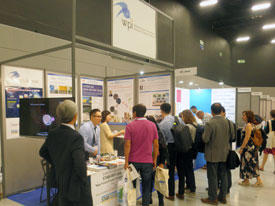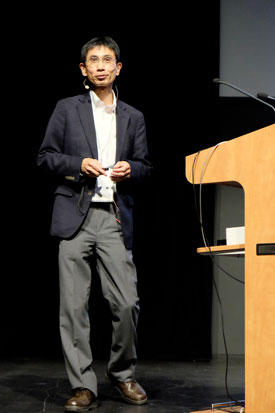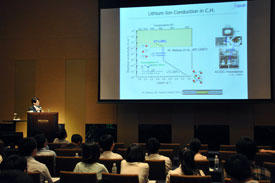

09/25/2018
To enhance global awareness of the World Premier International Research Center Initiative (WPI) and four WPI materials-related centers, researchers from the Advanced Institute for Materials Research (AIMR) attended the 2018 European Materials Research Society (E-MRS) Spring Meeting in June, where they helped manage a booth and run a workshop. This was the third time that the four centers — the AIMR, the International Center for Materials Nanoarchitectonics (MANA), the Institute for Integrated Cell-Material Sciences (iCeMS) and the International Institute for Carbon-Neutral Energy Research (I2CNER) — have jointly participated in the E-MRS Spring Meeting, which this year was held in Strasbourg, France.

The WPI exhibition booth provided an important platform to promote the activities of the WPI and the four centers to attendees of the 2018 E-MRS Spring Meeting. Over the three days that the booth was open, it attracted many European researchers, who browsed its posters and brochures while enjoying some traditional Japanese food and beverages. A wide range of researchers visited the booth — senior researchers who had stayed in Japan or had collaborated with Japanese researchers; young researchers interested in working at Japanese institutions; and participants from other booths who were curious about Japanese academic institutions. Outreach staff members from the four WPI centers managed the booth and were joined by WPI researchers between sessions. Such face-to-face dialog between WPI members and European researchers was very valuable for enhancing the profile of WPI and the four centers.

Also this year, the WPI centers held a joint workshop with the open-access materials science journal Science and Technology of Advanced Materials (STAM) about future developments at the frontiers of materials science. This joint workshop was born out of discussions held two years ago between members of WPI and STAM about the possibility of collaborating to highlight the activities of the entire material science community in Japan. At the beginning of the workshop, AIMR’s Susumu Ikeda explained the purpose of the workshop and introduced the framework of the WPI. His talk was followed by an introduction to STAM by its editor-in-chief, Shu Yamaguchi of the University of Tokyo. This was followed by five presentations about how materials science can contribute to realizing a sustainable society by researchers from four WPI centers and Swiss Federal Laboratories for Materials Science and Technology (Empa).
Hiroshi Yabu of AIMR talked about experimental and theoretical approaches for controlling the shapes of nanostructured particles made from polymers. His team has developed a simple method for fabricating block copolymer particles that have a variety of nanostructures by simple solvent evaporation from polymer solutions containing poor solvents. The unique phase-separated structures they obtained can be described by a mathematical model that was developed with the help of AIMR’s mathematicians. This method can be used to create new nanostructured materials that will help address medical and environmental issues.
The four WPI centers have jointly participated in E-MRS Meetings every other year since 2014 as it is proving to be an effective way to promote international exchange and collaboration.
Changing continents, the Tohoku−Tsinghua Joint Workshop on Materials and Spintronics Sciences is a good example of the effectiveness of promoting collaboration through long-standing efforts and mutual exchange with international partners.
The relationship between Tohoku University and Tsinghua University has been deepening over many years through active personnel exchanges — the two universities signed their first academic exchange agreement back in 1998. As part of Tohoku University, the AIMR has also cooperated with Tsinghua University. In particular, Qikun Xue, vice-president and professor at the Department of Physics of Tsinghua University and principal investigator at the AIMR, has made a vital contribution by playing a leading role in the collaboration. He is also chair of the Tohoku University Alumni Association in China and has acted as a bridge between the universities as well as the AIMR.
An important way to strengthen collaboration is to establish common research themes with partners, which leads to two-way exchange of information and researchers. To build closer ties with partners in this way, the AIMR has established joint research centers at the University of Cambridge in the UK and the University of Chicago in the USA, and it is now in discussions with Tsinghua University to create another joint laboratory in Beijing, China.
In December 2017, the first joint workshop on materials and spintronics sciences was held at Tsinghua University as part of Tohoku University Day. Some AIMR researchers participated in the workshop and took the opportunity to discuss a plan to establish a new joint research center at Tsinghua University. This year, the AIMR organized the second inter-university event: The Tohoku−Tsinghua Joint Workshop on Materials and Spintronics Sciences. This was a key event in Tohoku University’s new materials science research center, which is being established as part of the university’s new status as a Designated National University.

On 26 July, after signing a memorandum of understanding, plenary lectures, and a tour of Takashi Takahashi’s laboratory, the workshop was held at the Westin Hotel in Sendai. Both universities gave opening remarks, which were followed by two keynote speeches. Shin-ichi Orimo, of the AIMR and the Institute of Materials Research, Tohoku University, gave a talk on advanced hydride research for energy device applications, while Ke He of Tsinghua University described the search for intrinsic magnetic insulator materials.
Workshop participants then went to one of two parallel sessions: Novel Electronic Materials and Spintronics, and A New Stream of Structural and Functional Materials. Both sessions highlighted close interactions between the researchers at the two universities. Sometimes interactions went beyond research. For example, Jing-Feng Li of Tsinghua University obtained his PhD from Tohoku University in 1991 and worked at Tohoku University’s School of Engineering until 2002. He has played a key role as a mediator in the exchange between researchers from the two universities. Several Tsinghua University researchers have also conducted research at Tohoku University.
Through these international events, AIMR is strengthening its global network and enhancing its internationalization, which is a key mission of the WPI centers. The AIMR is aiming for even greater heights, namely to become a dynamic hub for global brain circulation.